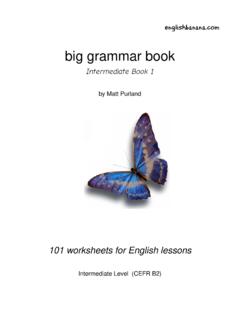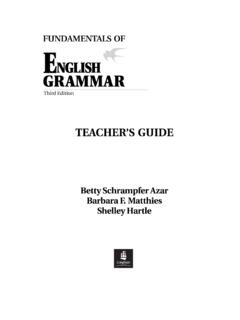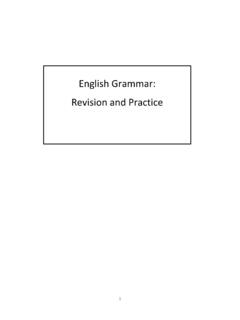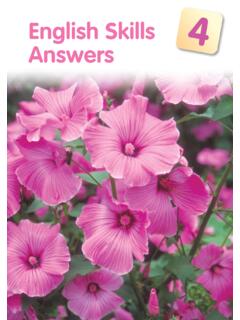Transcription of TEACHING SYLLABUS FOR ENGLISH LANGUAGE (PRIMARY 1-3)
1 MINISTRY OF EDUCATION SCIENCE AND SPORTSTEACHING SYLLABUS FOR ENGLISH LANGUAGE (PRIMARY 1-3)Enquiries and comments on this SYLLABUS should be addressed to:The DirectorCurriculum Research and Development Division (CRDD)P. O. Box , 2007 Republic of GhanaiiTEACHING SYLLABUS FOR ENGLISH (PRIMARY SCHOOL)RATIONALEThe status of ENGLISH LANGUAGE and the role it plays in national life are well known. As the official LANGUAGE , it is the LANGUAGE of government andadministration. It is the LANGUAGE of commerce, the learned professions and the media. As an international LANGUAGE , it is the most widely used on theinternet and in most parts of the world. ENGLISH is the medium of instruction from Primary 4 in the school system. This means that success in education atall levels depends, to a very large extent, on the individual s proficiency in the LANGUAGE .
2 It is for these and other reasons that ENGLISH LANGUAGE is a majorsubject of study in Ghanaian AIMSThe SYLLABUS has been designed to help the pupil to:1. develop the basic LANGUAGE skills of listening, speaking, reading and writing2. attain high proficiency in ENGLISH to help them in their study of other subjects as well as in the study of ENGLISH at higher cultivate the habit of and interest in reading4. communicate effectively in EnglishSCOPE AND CONTENTIn this SYLLABUS the subject integrates the receptive and productive skills of the languages into five sections as follows:Section 1: Listening and SpeakingSection 2: GrammarSection 3: ReadingSection 4: Writing and CompositionSection 5.
3 Library (Extensive Reading)iiiBACKGROUND KNOWLEDGE AND SKILLSAs preparation for the formal study of ENGLISH , it is assumed that pupils already have a background of two-year preschool LANGUAGE experience whichfocused mainly on the acquisition of oral skills and such pre-reading and pre-writing skills as visual discrimination, visual motor, visual comprehension,visual memory, auditory discrimination, auditory comprehension, drawing, colouring, painting, patterning, pattern writing and some OF THE SYLLABUSThe structure and organization of the SYLLABUS for each of the six years of primary education is presented in the following AND ORGANIZATION OF THE SYLLABUSPRIMARY 1 PRIMARY 2 PRIMARY 3 SECTION 1: LISTENING AND SPEAKING(p. 1-6)Unit 1: Listening, Reciting and SingingUnit 2: Story tellingUnit 3: ConversationUnit 4: DramaSECTION 2: GRAMMAR( 14)Unit 1: Naming Words- NounsUnit 2: Doing Words Verbs, Verb to be Unit 3: Commands/RequestsUnit 4: Verb Tense Forms Simple Present Present ContinuousUnit 5: Simple Prepositions in, on, under, near, behindUnit 6: Questions and Responses ( WH Questions) What, where, whoUnit 7: Pronouns (Personal) I, You, He, She, It, We, TheyUnit 8: Demonstratives: This, That, These, ThoseUnit 9: Describing WordsSECTION 1: LISTENING AND SPEAKING(Pg.)
4 24-30)Unit 1: Listening, Singing Songs and Reciting Rhymes and PoemsUnit 2: Story TellingUnit 3: ConversationSECTION 2: GRAMMAR(p. 31 37)Unit 1: Nouns Naming WordsUnit 2: Doing Words VerbsUnit 3: Questions and Responses (do, be, have)Unit 4: Doing Words: Present ContinuousUnit 5: Doing Words: Simple PastUnit 6: Doing words: Simple Present in Repeated (Habitual) ActionUnit 7; More Prepositions : up, down, into, in, in front ofSECTION 1: LISTENING AND SPEAKING(p. 45-50)Unit 1: Listening to Poems, Directions and InstructionsUnit 2: Listening to Directions and InstructionsUnit 3: Story TellingUnit 4: ConversationUnit 5: DramaSECTION 2: GRAMMAR(p. 51 58)Unit 2: Nouns NumberUnit 2: Verb Tense Forms : Subject Word AgreementUnit 3: Verb Tense Forms: Simple Past Past ContinuousUnit 4: Prepositions: Below, above, over, in front of, behind, nearUnit 5: Expressing the FutureUnit 6: Questions: and Responses (in the Future)Unit 7: Simple Quantifiers Cardinals/ordinalsUnit 8: Adjectives Describing WordsUnit 9: Possessive PronounsvPRIMARY 1 PRIMARY 2 PRIMARY 3 SECTION 3: READING(p.
5 15-17)Unit 1: Pre-Reading Activities Recognition/Discrimination of Objects Manipulating Objects (Kinaesthetics) Reading pictures and talking about them LANGUAGE Games Turing over the pages of a book (Picture scrap boos)Unit 2: Introduction to Formal Reading Phonological Awareness Letters of the alphabet Picture/object word matching Word recognitionSECTION 4: WRITING AND COMPOSITION( 20)Unit 1: Writing Patterns for Muscular Control and Hand-eye Co- ordinationUnit 2: Copying Letters and Simple WordsUnit 3: Drawing and LabellingUnit 4: Copying short sentencesSECTION 5: LIBRARY( )SECTION 3: READING(p. 37 - 39)Unit 1: Recognition of WordsUnit 2: Phonic Work Recognition of sounds in known words vowels Sound discriminationUnit 3: Introduction to Reading Comprehension Reading Short Sentences in Passages/PoemsSECTION 4: WRITING AND COMPOSITION(p.
6 40 41)Unit 1: Copy Work Copying words Lower case and Upper case lettersUnit 2: Copying from Simple Substitution Tables The full stopUnit 3: Spelling and Dictation Supplying missing letters and wordsSECTION 5: LIBRARY( 45)SECTION 1: READING(p. 59-61)Unit 1: Reading Aloud Reading GamesUnit 2: Silent ReadingUnit 3: Phonic Work Word AttackUnit 4: Making and Using Picture DictionariesSECTION 4: WRITING AND COMPOSITION(p. 61 63)Unit 1: Writing: Penmanship and Copy Work Purposeful copying of sentences, verses, words of songs, prayerUnit 2: Composition Writing short descriptions Punctuation full stop and comma. Upper case and lower case letters Subject/verb AgreementUnit 3: Exercises Involving Substitution TablesUnit 4: Sentence CompletionSECTION 5: LIBRARY( )viPRIMARY 4 PRIMARY 5 PRIMARY 6 SECTION 3: LISTENING & SPEAKING(p.
7 68-75)Unit 1: Listening to Songs, Poems and RhymesUnit 2: Listening to Instructions/Directions and carrying them 3: Story TellingUnit 4: ConversationUnit 5: DramaUnit 6: Polite RequestSECTION 4: GRAMMAR( 85)Unit 1: Nouns: Proper Nouns & Common NounsUnit 2: Comparison of Adjectives (Regular)Unit 3: Verb tense Forms: Simple Past, Present PerfectUnit 4: AdverbsUnit 5: Subject-verb AgreementUnit 6: Conjunction: and, but, so, forUnit 7: Anomalous Finites: can, could, mayUnit 8: Prepositions: below, above, over, behind, nearSECTION 1: LISTENING AND SPEAKING(p. 95-100)Unit 1: Listening to Songs/PoemsUnit 2: Listening to Instructions & DirectionsUnit 3: Story TellingUnit 4: ConversationUnit 5: DramaSECTION 2: GRAMMAR(p. 101 105)Unit 1: Nouns: Count Nouns and Non-Count NounsUnit 2: Comparison of Adjectives (Irregular)Unit 3: Simple Determiners: a, an, the, each, both, 4: Quantifiers: many, more, much several, few, a few, little, a littleSECTION 1: LISTENING AND SPEAKING(p.
8 118-123)Unit 1: Listening to Poems (Rhymes)Unit 2: Listening to Instructions and DirectionsUnit 3: Story TellingUnit 4: ConversationUnit 5: DramaSECTION 2: GRAMMAR(p. 122 133)Unit 1: Anomalous Finites (Modals must, have to, should, ought to, need to)Unit 2: Adverbs of more than one wordUnit 3: Word Groups PhrasesUnit 4: PrepositionsUnit 5: AdjectivesUnit 5: Direct and Reported SpeechUnit 6: DeterminersUnit 7: More about Quantifiers (Quantifiers some, any, few, a few, little, a little, many, much, both, all, a majority, the majority)Unit 8: Idioms and Idiomatic ExpressionsUnit 10: Question and Answer Tags using auxiliary verbs, - be, do, have, canviiPRIMARY 4 PRIMARY 5 PRIMARY 6 SECTION 3: READING(p. 81-82)Unit 1: Reading AloudUnit 2: Silent ReadingSECTION 4: WRITING AND COMPOSITION( 85)Unit 1: Penmanship: Joint scriptUnit 2: PunctuationUnit 3: Constructing Sentences from Substitution TablesUnit 4: Arranging Events and Ideas in Logical OrderUnit 5: Controlled: Simple Story Writing CompositionUnit 6: Simple Purposeful Communication, Writing Requests and CommandsSECTION 5: LIBRARY( 94)SECTION 3: LISTENING AND SPEAKING(p.
9 106-107)Unit 1: Reading AloudUnit 2: Reading and ComprehensionSECTION 4: WRITING AND COMPOSITION(p. 108 114)Unit 1: Penmanship: Joint ScriptUnit 2: Paragraph WritingUnit 3: Joining of ParagraphsUnit 4: Giving Directions in WritingUnit 5: Letter Writing Friendly LettersUnit 6: Description of Simple ProcessesUnit 7: Summary WritingSECTION 5: LIBRARY( 117)SECTION 3: LISTENING AND SPEAKING(p. 138-139)Unit 1: Listening ComprehensionUnit 2: Reading AloudUnit 3: Reading ComprehensionSECTION 4: WRITING AND COMPOSITION(p. 136 140)Unit 1: Penmanship: Joint ScriptUnit 2: PunctuationUnit 3: Letter Writing Semi-official letters Official lettersUnit 4: Letter Writing: Official LettersUnit 5: Writing Simple StoriesUnit 6: Writing Reports/Account of EventsUnit 7: Class Magazine WorkUnit 8: Argumentative EssayUnit 9: AdvertisementsUnit 10: Filling FormsSECTION 5: LIBRARY( 146)viiiSUGGESTED TIME ALLOCATIONP rimary schools are open for 40 weeks in a year.
10 This SYLLABUS is expected to be completed within that period allocations are as follows:LOWER PRIMARY(Regular)LOWER PRIMARY (Shift) UPPER PRIMARY (Regular)UPPER PRIMARY(Shift)Listening and Speaking2121 Reading2222 Writing and Composition2222 Grammar 1111 Library1111 Total8777 Apart from the time allocation for the subject itself, schools are advised to provide the following recommended time for the subjects/items listed below: Physical Education 4 Library Work (Reading and Research) 3 SBA Project 2 Worship 2 SUGGESTIONS FOR TEACHING THE SYLLABUSThis SYLLABUS has been developed very carefully and with a lot of consultations with the aim of helping to improve the standard of ENGLISH in Basic this section very well in order to be able to use the SYLLABUS very start with, bear in mind that your class may consist of one or few pupils with different physical problems and mental abilities.






